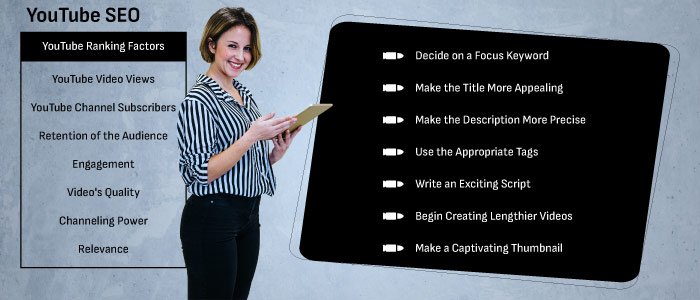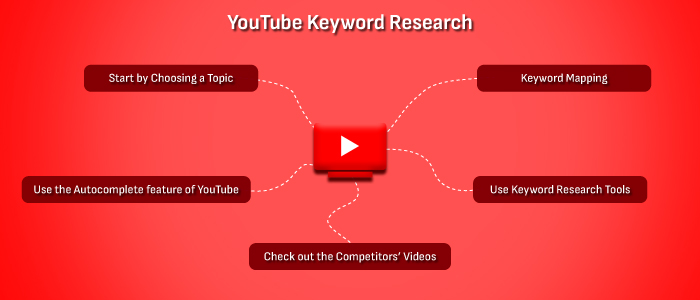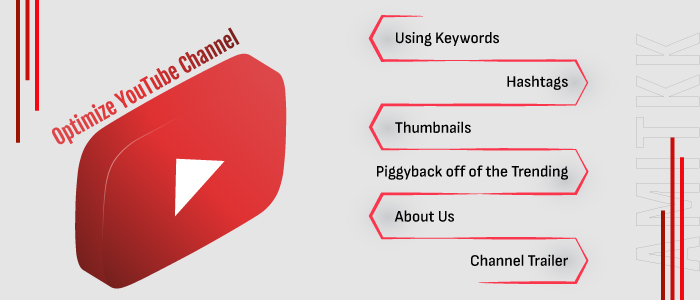YouTube Keyword Research: We all know how popular YouTube is; it is the second most used social media network after Facebook. The platform not only has billions of viewers but is also a popular search engine and is placed right after Google. With more than 500 hours of videos uploaded daily, the platform provides a lot of content to watch.
However, getting your videos to rank above others on this highly competitive social media platform can be quite challenging. Although YouTube SEO and regular SEO services are closely related, they are different in their ways. Before you take any step, make sure to treat YouTube differently than Bing or Google.
YouTube is a search engine; however, it is for videos and not for text content. Hence, there are a set of practices creators can use to achieve positive results. YouTube videos need to be optimized with keywords, descriptions, and titles to rank better on both YouTube and other search engines.
YouTube Keyword Research – What exactly is it?

Is the YouTube keyword the same as the other keywords? Yes, it is. But what makes it so special?
The YouTube keyword can be a phrase or a single word that can explain what the video is all about to the viewer. And this keyword should match the word or the phrase the viewer types in the YouTube search box when looking for a related topic/subject.
What makes it important to pick the right keywords by taking the needed time for research. Once you know what your target audience wishes to see, you can create a video based on their needs. As a content writer, using the right keywords can help you obtain a good number of page views and likes and increase the number of subscribers.
As the audience on YouTube has a lot of content to pick them, they are quite demanding. Thus, YouTube keyword research plays an important role in getting more views. Let us now look at different ways to choose the right keywords and increase the views of YouTube videos.
How to find the Right Keywords

Below are a few key steps to finding the best keywords for your target audience and topic.
Start by Choosing a Topic
The very first step of keyword research is choosing the right topic. While this might seem easy, it is always important to have a strong and trending topic. The topic you pick needs to be broad too, and something your target audience might be interested in. If you are starting a new channel, brainstorm and write down a few topics, you think you are good at.
Use the Autocomplete feature of YouTube.
Now that you have your topic, you can find the right keywords using the autocomplete feature on YouTube. It will give you a fair idea of what the viewers are looking for. If you find that the topic is oversaturated or if you do not find enough info via autocomplete, you might rethink if the topic is worth working on.
Check out the Competitors’ Videos
Once you open a popular video from your niche, right-click on the mouse and click on the option that says "View Page Source". The HTML code of the page will open in another window. Now use “Ctrl+F” and type keywords in the open search box. You can then see the keywords highlighted. You can also use a few chrome extensions to check the keywords used by your competitors.
Use Keyword Research Tools
There are a wide number of keyword research tools available. Some of these are free, whereas others come with a monthly subscription. You can use Google AdWords or the Keyword Magic tool for the same.

How to Obtain More Views on YouTube Videos?
Now that you have noted the topic and the related keywords, we need to know how to use them effectively. The correct usage of the keywords can bring more video traffic. The whole process is not as complicated as it sounds and takes little of your time.
Let us now have a look at a few tips on how you can make YouTube keywords work the magic for you.
Keyword Mapping
Once thoroughly research your keyword, you can use the same for keyword mapping. In simple terms, keyword mapping is matching specific keywords to videos. Creators can start by noting the top keyword in a spreadsheet and then add them to the YouTube videos they go well with.
Your keyword map needs to include elements like the important keywords, the monthly keywords you intend to use as per the search volumes, the current search ranking of the keywords, and the video URLs that match the best with the keywords you have.
However, it is important to know that you can always optimize a video using multiple, but do not optimize several videos for the same keyword.

Understand the Search Intent
YouTube, a search engine, intends to provide its users with the information they are always looking for. What makes search intent the backbone for keyword research and optimization?
If you want your YouTube video to rank high, you need to grasp the basics behind search intent. At times, the terms used in the search on YouTube are pretty easy to understand, for example, iPhone 11S Review. By this, you know what the customer is looking for. Sometimes, the search term can be "iPhone," making it hard to understand what the user is looking for.
To match the users' search intent on YouTube, you need to know the sales funnel better. The four sales funnels that can help you make better content and pick the right keywords are,
- Awareness applies when the user's search intent is to know about a specific product. For example – "What is a noise-cancelling headphone?"
- Interest – This applies when the user's search intent has a goal. For example – "100M noise cancelling headphones from X brand."
- Decision- This type of search intent helps the user make a better decision about a purchase. For example – "Top Bluetooth headphones in India."
- Action – This search intent helps the user make a final purchase. For example – “Buy Sony MX noise cancelling headphones."

Include the Keywords in Hashtags
You can also use proper hashtags to drive more traffic to your videos. YouTube hashtags are the keywords that can be added to your video and helps you gain the attention of your target audience. Use your top-ranking keywords in the hashtags, as it allows your videos to appear in searches. However, only add the keywords/hashtags relevant to the video content. To rank your video top on youtube, connect with a leading digital marketing company at a very affordable price.
Major Myths About YouTube Keyword Research
As YouTube continues to grow in popularity, many marketers are turning to YouTube keyword research to help them get their videos seen. Unfortunately, a few misconceptions about YouTube keyword research can lead to wasted time and effort if you’re not careful. Here are the five most common myths about YouTube keyword research and why they’re wrong.
You Don’t Need To Do Keyword Research
Many people mistakenly believe that uploading a video and then properly tagging and describing it is all that is required to gain exposure. This is vital, but more is needed. When determining a video’s placement in a user’s suggested videos, the YouTube algorithm considers more than just the tags and descriptions. In addition, it takes into account metrics like the total number of views, average viewing duration, and clickthrough rates. Therefore, keyword research is essential for optimizing your videos for optimal discovery by the intended audience.
You Don’t Need To Use Long-Tail Keywords
Long-tail keywords are often longer and more specialized phrases than shorter ones. A common misconception is that broad phrases will get better results than more specific ones (long-tail keywords). It’s only sometimes the case, though. Using long-tail keywords is an effective strategy for increasing the quality and quantity of your YouTube traffic.
You Should Focus On Volume
While doing YouTube keyword research, many individuals focus most of their attention on a keyword’s volume or frequency of use. Despite how important it is to think about the keyword’s search volume, it is not all you should consider. When selecting a keyword, you should consider the competition’s difficulty and the user’s goal when searching. Use this to find terms that could increase your visits and interaction levels.
You Don’t Need To Monitor Your Keywords
Finding the proper keywords is only the beginning of the process. The success of your videos and the continued applicability of your keywords are both something you should keep an eye on. This may ensure your videos get seen by the proper people and that you’re always current with the times.
You Can Use The Same Keywords For All Your Videos
Many people think they can use the exact keywords for all their videos, but this isn’t the case. Instead, each video should have its own set of keywords tailored to the specific topic of the video. With this, you’ll be able to attract a more specific audience, boosting your video’s ranking in YouTube’s algorithm.
A few examples of YouTube keyword research misconceptions are listed above. If you want to see your videos, you must do your research and make sure you’re using the right keywords.



















 Seo Company In Mumbai
Seo Company In Mumbai  Digital Marketing In Chennai
Digital Marketing In Chennai  Digital Marketing In Ahmedabad
Digital Marketing In Ahmedabad  Digital marketing in Bangalore
Digital marketing in Bangalore  Digital Marketing Company In Delhi
Digital Marketing Company In Delhi  Seo Company In Delhi
Seo Company In Delhi  Local Seo
Local Seo  Technical Seo
Technical Seo  Digital Marketing In Noida
Digital Marketing In Noida  Digital Marketing In Gurgaon
Digital Marketing In Gurgaon  Digital Marketing In India
Digital Marketing In India 




